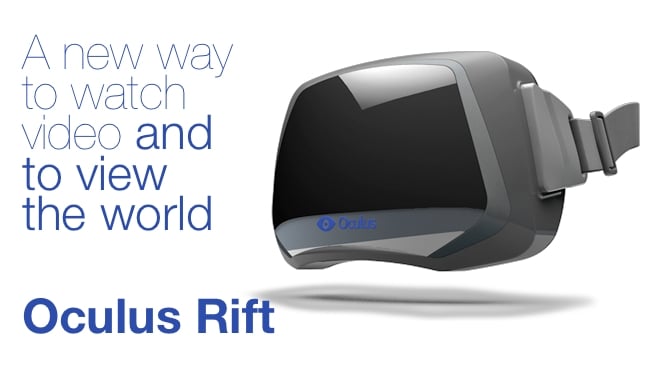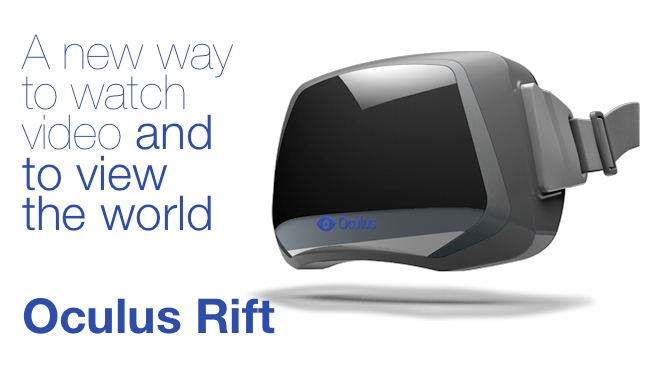
 Oculus Rift
Oculus Rift
All eyes are on bigger displays, from projectors to the 4K tidal wave on the horizon, but what if the next revolution is something that's already here?
There's war brewing in the battle to dominate our viewing habits. It's exciting (as our 4K coverage from NAB has proven), it's confusing (as developers and platform-holders struggle to find their niche and identify the new frontier) and it's, ultimately, going to lead to the biggest living-room land-grab since the CRT-to-1080p HD revolution.
The truth is that this paradigm shift is much bigger than the days of CRT versus HD and makes that old spat of HD DVD versus Blu Ray look like a minor skirmish. This time, not only is the hardware changing but our entire way of consuming media has already undergone massive disruption. Consumer tastes are mutating thanks in large part to the friction-free nature of services like NetFlix, and platform-holders like Sony, with its streaming-focused PS4 announcement earlier this year, are doing their best to predict the direction - and cater to the tastes of - the migrating masses.
The living-room struggle
We've already seen major players in the living-room space struggle. Nintendo attempted to introduce a second-screen of its own into the living-room ecosystem with Wii U and all signs thus far point to a miscalculation: however ergonomic and appealing Nintendo's Wii U gamepad is, most consumers already have a second screen they're devoted to that does everything the gamepad can and more. It's only early days, of course, and Nintendo is the master of the slow-burn comeback, so don't count them down for the count just yet.
As the war over the second-screen continues, with PSVita taking up arms as it plays a stronger role in Sony's Playstation ecosystem alongside PS4, Oculus Rift is parachuting into all territories this month like a silent assassin. A head-mounted display built with Windows-based gaming in mind, Oculus Rift is a Kickstarter success story, sailing past its $250,000 dream figure towards $2.5 million and now very nearly a reality for retail consumption.
Positive
Early reports have all been extremely positive, the gaming press are convinced - enamoured even - by its ability to immerse you in the world of a firstperson game like Team Fortress 2 or Hawken with its development version's display projecting at a split 640x480 resolution per-eye (the consumer model is purported to be targeting a higher-fidelity 1080 display).
What very few people are talking about, however, is the Rift's potential to be a more general media viewer, a competitor for that second-screen space and the likes of Sony's HMZ personal viewer series, for example, but one with a more open gate to developers and programmers. Rift also poses a much stronger value proposition than the likes of the HMZ series, rumoured to be targeting a $300 price-tag for its retail debut compared to HMZ's £1000 ballpark. And then there's the fact that it can conjure stereo 3D with ease, offering a tantalising proposition for movie companies to uncover a new niche for all those post-production 3D conversion projects.
Though no plans have been announced for Rift as a more general piece of media delivery, you can't help think it's only a matter of time with that HDMI-ready input gazing out from those goggles.
Threat to 4K?
You might even wonder, with its plans for up-close-and-personal 1080 viewing, whether Rift could pose a threat to the burgeoning 4K television market. It's possible, but I don't think it's likely. For a start, by its very nature, Rift is a personal, isolated experience. The appeal of 4K lies in its ability to deliver an unprecedented communal experience, to render the "cinema of attractions" to use an old Hollywood term, while Rift and the second-screen market of Nexus and the iPad are all about the lone consumer. Secondly, Rift currently lacks audio support, meaning that while it's a solid value proposition as it stands, the need to shell out for high-end audio devices to match the calibre of the visual experience may off-set some of that cost-effectiveness, where 4K sets will likely bring with them an array of cutting-edge audio implementations and options.
Issue of control
There's also the issue of control and tactility. A major appeal of the second-screen revolution was the dawn of a tactile interface, and Oculus Rift appears to be very much locked into the ecosystem of current videogame controllers. Game controllers like the Dualshock 3 are design classics and function without equal for navigating virtual spaces, but for simply inputting text into virtual keyboards and navigating the worldwide web they're cumbersome and offer a sluggish mechanism.
The likes of Valve Software's Daisywheel is a solution, but it still pales in comparison to a retina-equipped iPad for speedy navigation. Perhaps the virtualisation of the web itself, with websites drawn like corridors, is the way forward for VR in this aspect but that'd be a heck of a job and a long, long way off in the distant future if it's even viable at all.
Oculus Rift, with its low latency, fast head-tracking performance, is winning over the gaming press, and soon will likely conquer the gamers themselves, but it's the potential for the technology to win the greater war for a portion of our more general viewing habits that has us intrigued, and should have those companies tirelessly chasing that second-screen market both excited and anxious about this unexpected new kid on the block.
Tags: VR & AR


Comments